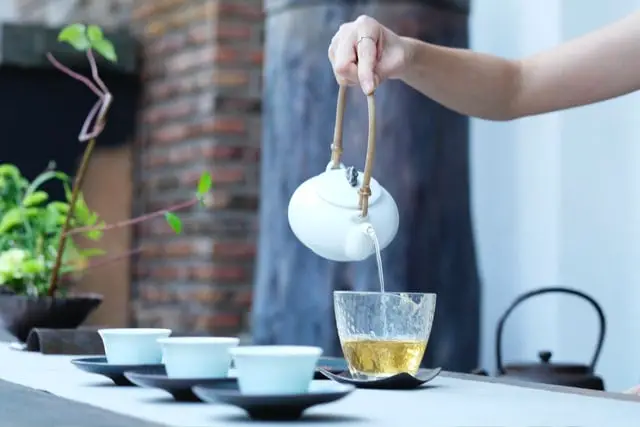
Are you wondering whether to boil tea leaves?
Well, you usually don't.
For the most part, water is boiled separately and then poured into a cup where the tea is steeped for a few minutes.
But this isn't always the case. Some recipes tend to make use of boiling for a stronger flavor.
As a life-long tea drinker, boiling tea leaves can sometimes work. Read on for the full scoop.
Contents
Technically speaking, no, you aren’t supposed to let tea boil.
In fact, most people don’t ever place their tea leaves in the same vessel that is heating or boiling their water.
Instead, tea leaves are poured into a cup or pot and then the hot water is poured into this container.
The tea leaves are then allowed to steep in the hot water until they have reached an appropriate strength.
However, if you were to take a history lesson, you would learn that when tea was first discovered, the leaves were boiled in water.
It was only later on that the process of steeping began to take place.
What’s more there are cultures today that continue to boil their tea leaves.
Let’s take a look at some of these in the section below…
Related Articles
How Many Times Can You Use a Tea Bag?
Lift It Up and Pour It Out: How to Use a Teapot

Here are some of the countries that boil their tea leaves:
One of the most popular beverages in Morocco is mint tea. A version of this is enjoyed in a variety of Middle Eastern countries. In addition to being a local treat, this is a beverage that many tourists come to love as well.
Now, the process of making mint tea is interesting. For one thing, the locals use gunpowder green tea which they proceed to boil along with mint. In fact, the leaves are well and truly boiled with this beverage. A fair amount of sugar is added to make this a wonderful treat.
Masala chai is a brew that is enjoyed by millions of Indians each and every day. This drink is so delicious that it has even become popular all the way over in the US as well. This drink is most notable for its use of spices such as ginger, cardamom, cloves, and cinnamon along with black tea.
Instead of being steeped, the black tea leaves are boiled in either water or milk that also contains the spices. This imparts a far bolder flavor, complementing the other spices. Masala chai can be a bit sweet, on occasion.
For the most part, the Japanese brew their green tea to perfection using traditional methods. However, there is one exception – Royal Milk tea. Here, you brew black tea with either Assam or Darjeeling tea leaves. These are simmered in water.
Since this method results in a more robust cup of black tea, a fair amount of milk is added to the drink as well. This helps to cut down on the bitterness while simultaneously adding a creamy effect to the beverage.
Then, there is Mongolian tea. This recipe starts off by boiling green tea leaves and water together. You will then add the milk to the beverage and then bring it to a boil once more. Just as interesting is the fact that you add salt and not sugar to this brew!
So, it’s clear that some regions do boil their tea leaves with great success. However, there are some instances in which you shouldn’t boil tea.
Black tea has a higher concentration of tannins.
This type of tea will readily release tannins when it is placed in water.
It will do so even more readily at higher temperatures.
So, what is the downside to this phenomenon? Well, tannins can cause black tea to become bitter.
Thus, a higher concentration of tannins will produce a bitter brew.
Not to mention, tannins can also cause certain digestive issues in some people.
It should be noted that oolong tea has the next highest concentration of tannins. As such, you shouldn’t boil it either.
Most people drink green tea for its health benefits.
Now, these benefits are largely due to a substance known as catechins.
However, higher temperatures can destroy catechins, lowering the nutrient value of green tea.
As with black tea, boiling water can also make green tea quite bitter.
White tea is just as delicate as green tea and should not be exposed to very hot water either.

So, when is it possible for you to boil tea leaves?
Well, as you will have seen from above, boiling tea leaves cause it to lose its nutritional properties.
Thus, you should only boil the leaves if you are looking for a tasty, exotic tea instead of a healthy one.
There is no denying that Moroccan, Indian, and Japanese tea are delicious.
However, the nutritional elements of the tea may be negated by the boiling method.
Thus, these drinks should only be considered as a treat.
Well, in the instances that you do boil tea leaves, how long should you boil it for?
In many cases, the tea leaves are brought to a boil with the water.
And, then, they are allowed to simmer for a few minutes.
It is unwise to allow the leaves to boil for any longer than this as you run the risk of making the tea too bitter.
To stay on the safe side, always follow the instructions to the letter.
Of course, if you are interested in brewing tea for health purposes, here is your guide to doing so:
White tea is the most delicate of the teas. Due to this, you have to be very careful about the temperature.
This means that you have to use water that is well below the boiling point.
The ideal temperature for brewing white tea is around 160°F.
This means that you should take the water off the heat the moment that small bubbles begin to appear.
Related Articles
Shining a Light on the Best White Tea Brands
Green tea, too, has to be brewed with water that has been taken off the stove before it begins to boil.
The best water temperature for this tea is between 150°F and 180°F.
Once small bubbles begin to rapidly rise to the surface, the water is ready.
Related Articles
Forty Shades of Green: The Best Green Tea Brands for a Refreshing Brew
Oolong tea is a little more robust.
Due to this, you can use water that has been heated to around 190°F and 200°F.
You can take the water off the heat when you begin to notice medium-sized bubbles and a moderate amount of steam.
Related Articles
Spilling the Tea: Your Guide to the Best Oolong Tea
Black tea can withstand the greatest amount of heat.
Nevertheless, it is important to not use water that has been boiled for too long.
Use water that has been heated to 200°F to 212°F.
You can stop heating the water once large bubbles have appeared and when there is a lot of steam.
Related Articles
Loose, Bagged, Organic: Find the Best Black Tea on the Market
It is clear that there is a lot more to boiling tea leaves than you may have initially anticipated.
Now that you have the full story, though, you are aware of the dos and don’ts of boiling tea.
If you enjoyed this post, head over to our Pinterest page. We have plenty of pins on the best way to brew tea.
